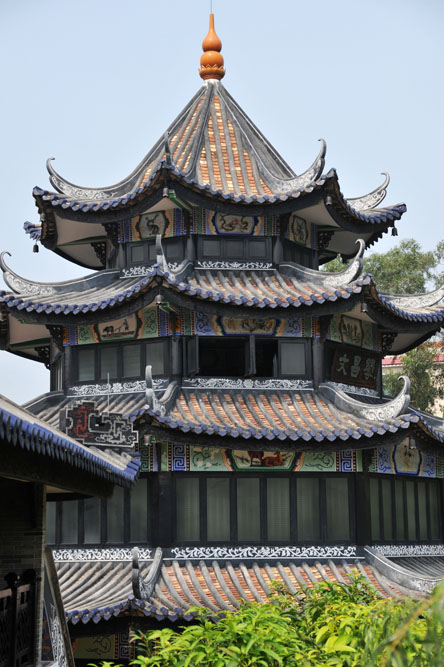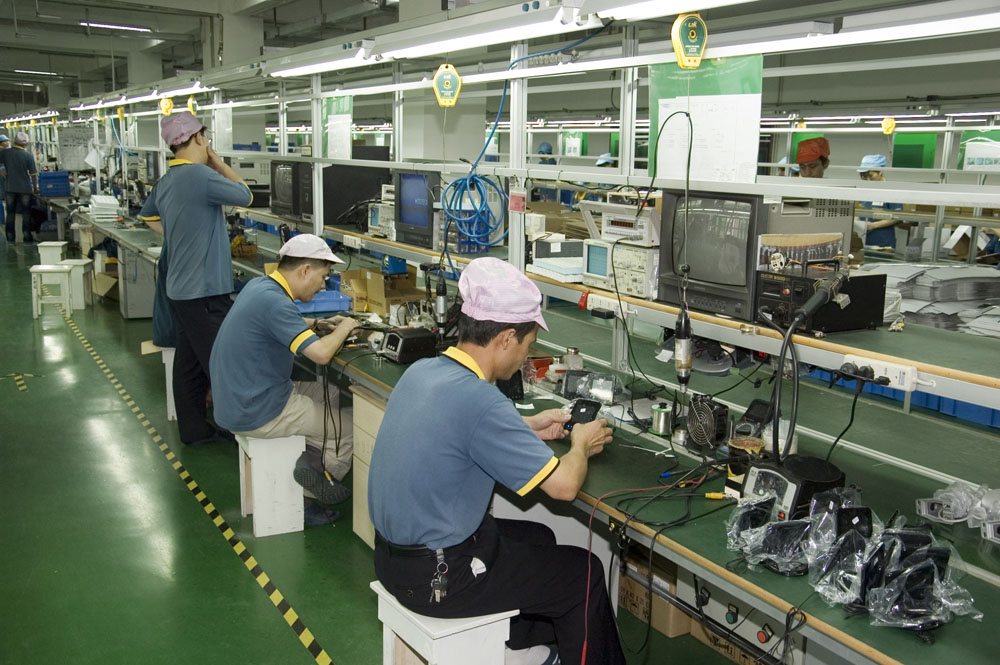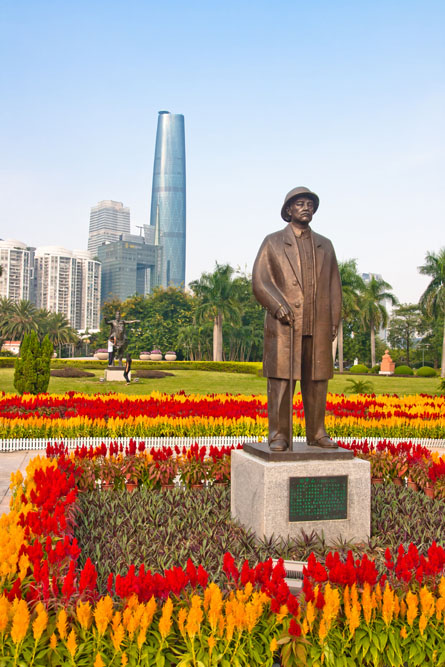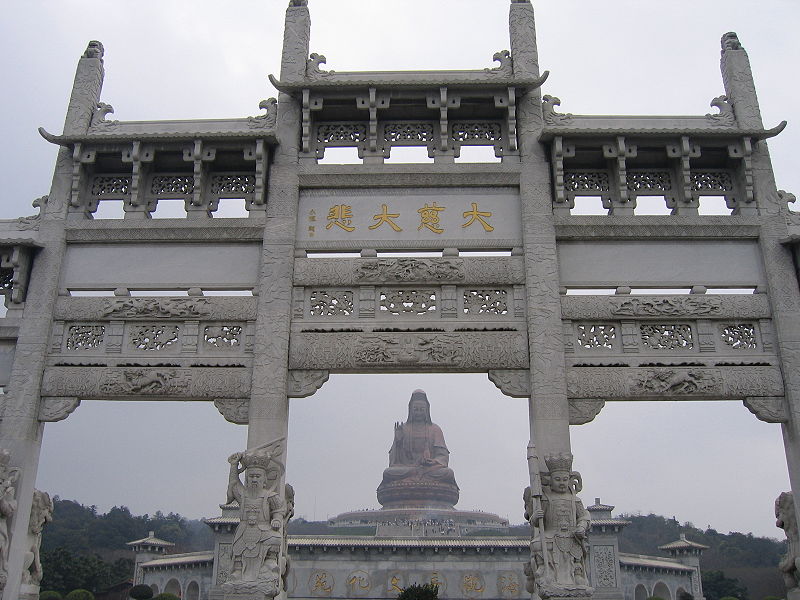Guangdong Province
Background
Guangdong is China’s southernmost mainland province. At approximately 197,000 km2, Guangdong is about 16,000 km2 larger than Cambodia. Guangdong has one of the longest coastlines of any province, and is linked to the two special administrative regions of Hong Kong and Macau. It is also bounded by the Guangxi Zhuang Autonomous Region to the west and by the provinces of Hunan and Jiangxi to the north and Fujian to the northeast. In the past, Guangdong and Guangxi were governed as one entity. Guangdong was first ruled independently in 997 CE, and it became known as Guangdong ‘expanse east’ as separate from Guangxi ‘expanse west’. Guangdong’s capital Guangzhou has been historically referred to in the West as Canton, from ‘Cantão’, the Portuguese transliteration of Guangdong. The predominant dialect of the region is still commonly referred to as Cantonese in English.

Ancient Pavilion
Guangdong’s coastal position has made it unique in China in that it has been allowed it to have maritime contact and trade with the outside world for over a millennium. Indeed, the Romans were the first outsiders to make it to its shores in 2nd century AD. Guangdong was originally home to non-Han ethnic groups such as the Yao and the Zhuang. This began to change when Guangdong’s Xi and Bei river valleys were first conquered by the Chinese empire during the Qin Dynasty, (221-206 BCE). By the Han Dynasty (206 BCE–220 CE), the whole of what is now Guangdong came under the China’s political control.
From 581 CE onward, Han migration into Guangdong began slowly to pick up pace as growing international trade created more economic opportunity. By the Tang Dynasty (618-907 CE), Arab merchants frequently docked at its shores and Guangdong had a sizeable trade with the Middle East and Southeast Asia. The southward movement of the Han into Guangdong increased pace from 1126 CE when the northern Song Dynasty was overrun by a coalition of nomadic tribes from the Mongolian steppes. Another major Han migration into Guangdong occurred a century and a half later when China was entirely conquered by the Mongols during the Yuan Dynasty (1279-1368 CE). As more Han migrants arrived, the other ethnic populations were largely assimilated into Han Chinese culture or were displaced to the northwest. By the 16th century, Guangdong’s population had grown so rapidly that its first residents began to emigrate out of the province, first to Guangxi, Sichuan, and Taiwan, and then in the mid-19th century to Southeast Asia and North America. The province is still a major source of Chinese emigrants abroad which has returned to it both overseas earnings and new ideas.

Traditional Chinese Opera
In 1557 the Portuguese arrived on Guangdong’s shores beginning Western trade with China. Western merchants were soon followed in 1582 by missionary Jesuits who made their home in Zhaoqing, west of Guangzhou. The British and the British East India Company began plying Guangdong’s waters by the 17th century. By 1757, an imperial Chinese edict restricted all Chinese foreign trade to Guangdong’s Shamiam Island. By 1773, the British began selling opium to the Chinese in order to reverse its trade deficit. Opium addiction spread rapidly. China’s effort to stop the opium trade eventually led to the Opium Wars, beginning a period of foreign incursion in China. In addition to Macau which had become a Portuguese colony, Hong Kong was given to the British, and Kwang-Chou-Wan (Guangzhou Wan) was ceded to the French.
Guangdong’s isolated position at the frontier of China and its constant contact with outside ideas meant that Guangdong has always been a place at the forefront of revolution and political thought within the Chinese empire.
After suffering greatly during the Cultural Revolution, Guangdong’s fortunes began again to rise after Deng Xiaoping’s open door 1978 policy established the first special economic zones in the Guangdong’s cities of Shenzhen, Zhuhai and Shantou, bringing capitalism into Communist China for the first time. When China’s economic reforms appeared to be threatened by internal opposition, Deng chose to tour the province in his famous ‘Southern Tour’ of 1992 to reaffirm his commitment to the process. Guangdong has remained at the forefront of China’s reform and opening up and is now a leading export center with the highest GDP of all China’s provinces.
People

Dancers
With a population of approximately 114 million people, Guangdong is China’s most populous province. It is estimated that approximately 80 million of these are permanent residents. The rest are migrant workers, often called the ‘floating population’, who live in the province for at least six months of the year in order to work in Guangdong’s factories. The China Labor Bulletin estimated that there are approximately 288 million rural migrants in China. Guangdong hosts the largest floating population followed by Beijing, Shanghai and Zhejiang. The influx of these migrant workers into Guangdong has been one reason that province’s population has increased rapidly. In 1982, its population was only approximately 60 million. Guangdong’s capital Guangzhou and its economic hub of Shenzhen are now among the most populous cities in China. Indeed, almost all of Guangdong’s Pearl River Delta is now highly urbanized, and some two-thirds of the province’s residents live in cities.
Ethnically, Guangdong is primarily Han Chinese with ethnic minorities representing only a tiny portion of Guangdong’s population. These minorities include the Yao, Hakka, Zhuang, She, Miao, Li peoples. The most common language of the province is Cantonese. Interestingly, Guangdong has a significantly unbalanced gender ratio that is among the highest of all Chinese provinces; in the 1-4 age group, there are estimated to be only 100 girls for every 130 boys.
Economy

Factory Workers
According to China’s National Bureau of Statistics, in 2018 Guangdong’s GDP was approximately $1.4 trillion, the largest GDP of all China’s provinces. Its GDP per capita was about $12,332. Overall, its GDP accounts for 10.6% of China’s total which was generated by 8.1% of China’s population. Its GDP per capita is ranked 8th out of China’s 33 provinces, municipalities, and autonomous regions. Its economic activity is divided between 4% primary industry, 42% secondary and tertiary is 54%.
The fertile Pearl River Delta is rich in fish and rice. In addition to rice, its primary agricultural crops include vegetables and fruit including pineapples, bananas, oranges, longans and lychees. In terms of aquaculture, in addition to excellent access to the sea, the province has many reservoirs and fishponds in which it breeds marine stock. Additionally, forests cover approximately 57.5% of the province providing it with significant timber reserves. Tree species include pine, fir, Chinese catalpa and eucalyptus.
Due in large part to its proximity to Hong Kong, Guangdong also has the largest export value of all China’s municipalities and provinces, accounting for approximately 28% of China’s export total in 2017. Guangdong’s ’s Pearl River Delta Economic Zone generated almost 85% of the province’s GDP in 2017. This zone stretches across nine cities including Guangzhou, Shenzen, Zhuhai, Foshan, Jiangmen, Dongguan, Zhongshan, Huizhou and Zhaoqing.
Guangdong has rich mineral resources. Approximately 129 minerals have been discovered within the province, 92 of which have proven reserves. These include coal, manganese and shale oil deposits as well as reserves of tungsten, bismuth, molybdenum, tin, germanium, tellurium and uranium. These deposits led to the establishment of some metal and petrochemical processing in the province during the Communist era. The province was also a center of machinery manufacturing, shipbuilding and ship repairing. That said, poor transportation links to the rest of China caused it to remain a relative backwater until the early 1980s.
Light industry has always been present in the province. Before the 1978 market opening, Guangdong was a center of food processing and the textile production. After three of China’s first four special economic zones were created in Guangdong, its light industrial production grew dramatically, especially textile and soft drink manufacturing. Since 2000, however, some of this light manufacturing has shifted away from low-value textiles to higher value-added industrial sectors including communication equipment, computers, televisions, refrigerators, electrical machinery, automobiles, electrical power and heat, metal products, electronics, toys, television sets, electrical fans, refrigerators, petrochemicals, motorcycles, building materials, paper, pharmaceuticals and information technology. This trend is expected to continue. Much of Guangdong’s production remains for the export market. Guangdong is home to the production facilities and offices of many foreign multinationals and major Chinese corporations.
Services accounted for approximately 54% of GDP in 2017. Guangdong is especially strong in financial services as well as modern logistics and related industries such as road transportation, warehousing, loading and unloading, processing, packaging, delivery, and consultancy services. Leasing and real estate are also strong tertiary industries within the province.
Guangdong’s rapid economic development has been driven by significant investment, particularly from Hong Kong and Taiwan. Between 1979 and 2017, Hong Kong alone invested approximately $272.8 billion dollars in the province. Its total direct investment in 2017 was about $23 billion dollars. Correlated with this investment, Guangdong has been able to develop a robust private sector. In 2017, there were approximately 3.82 million private enterprises in Guangdong, an increase of 20.3% from 2016.
Lay of the Land

TV Tower
Guangdong is divided from the Yangtze River basin by the Nan Mountains, the most southerly of the major Chinese mountain ranges running east to west. About 70% of the province is blanketed by rolling hills ranging in elevations from 450 to 750 m. Flat land is located predominately in its alluvial deltas, formed where its rivers empty into the South China Sea. Altogether, Guangdong has some 1,300 large and small rivers, the most important of which are the rivers which flow into the Pearl River Delta system. Extending some 7,500 square km, the Pearl River Delta is defined by the merging of the three major rivers of the Xi River system -the Xi (West), Bei (North), and Dong (East) rivers. The Pearl River extends southward from Guangzhou, pouring into a triangular estuary encompassing both Macau and Hong Kong as well as hundreds of smaller islands.
After the Pearl River system, the Han is Guangdong’s most important river. Because of Guangdong’s rapid industrialization, many of these rivers are now significantly polluted. Adjoining the South China Sea, Guangdong enjoys a coastline of approximately 3368 km. Leizhou Peninsula is on the southwestern end of the province.
Interesting Aspects for a Traveler

Modern Guangzhou
Guangzhou’s history is marked by sea trade and revolutionary thought. This history can be seen in its museums, architecture, temples and natural features. Its outstanding museums include: New Guangdong Museum, showing Cantonese Art and Chaozhou woodcarvings; Guangdong Overseas Chinese Museum, showcasing the history of Chinese overseas emigrants; the Memorial Hall of the Lingnan School of Painting, exhibiting contemporary ink and brush works in the Lingnan style; the Whampao Military Academy, which trained the leading Nationalist and Communist Chinese military leaders from the 1920s until it was destroyed by the Japanese in 1938; Xinhai Revolution Museum which commemorates the 1911 Xinhai Revolution; the Memorial Museum of Generalissimo Sun Yat-sen’s Mansion, where Sun Yat-sen lived between 1917 and 1923; Guangdong Museum of Art, exhibiting Cantonese artists; Guangzhou City Museum, illustrating the history of Guangzhou starting from the Neolithic period; and Guangzhou Museum of Art, displaying ancient to contemporary Chinese art and sculpture. Also of interest is the Mausoleum of the Nanyue King, protecting the tomb of Zhao Nanyue, who was the second king of the kingdom of Nanyue dating from 214 BCE.
Foshan, an hour by bus from Guangzhou, is home to Zu Miao – an 11th century temple complex in honor of Beidi, the God of the North. Cantonese opera is still performed here. The Nanfeng Ancient Kiln once produced most of the famous Ming-era ceramics so coveted in the West. Foshan was also the birth place of Kung Fu masters Wong Fei Hung and Ip Man, who was the teacher of Bruce Lee.
Yangjiang, in Guangdng’s south, is home to some of Guangdong’s best beaches, and the Maritime Silk Road Museum which houses an 800 year old Song Dynasty shipwreck.
The town of Zhaoqing was once home to China’s first Jesuit missionary Mateo Ricci in 1583. It is now the location of the Seven Star Crags Park showcasing karst limestone landscape features, original city walls and the Plum Monastery, dedicated to the father of Zen Buddhism. Close to Zhaoqing are the ancient, Feng Shui villages of Licha Cun and Xiangang Cun which showcase architectural features such as ‘wok-handle’ roofs radiating from a yin-yang symbol.
The Nanling National Forest on Guangdong’s northern border is home to the province’s oldest forests which include the blue pine species, unique to the area. The reserve is filled with excellent hiking trails.
Shenzhen is one of China’s most modern and populous cities. It is also an excellent transport hub from which to visit the province. The city itself is a perfect example of China’s recent history of development, having expanded from a fishing town of around 60,000 in 1978 to a metropolis of almost 15 million today. It is home to the Shenzhen Museum, showcasing the city’s economic transformation after market opening and the Art Terminal exhibiting Chinese modern art. Around Shenzhen, Dapeng Fortress was a key battle ground during the Opium Wars.
Along Guangdong’s coast, in Chaozhou, is found tranquil West Lake dividing Chaozhou’s old town from the new. Its famous Guangji Bridge which is a 12th century pontoon bridge once supported by as many as 86 boats straddling the water is the highlight of this delightful little town. It is also home to the 1887 Jilue Huang Temple which is known for its woodcarvings. Other temples worth visiting include Kaiyuan Temple, known for its old Bodhi trees and statues, and Hanwen Temple which is dedicated to the Tang-era philosopher Han Yu. Close to Chaozhou is Daoyunlou, China’s largest octagonal Hakka people residence, which once provided communal living and defense for 600 villagers.
Just west of Chaozhou, Meizhou and its surrounding area has many examples of Hakka- style coiled dragon houses, as well as traditional round Hakka houses. Meizhou itself features a small Hakka Museum.


